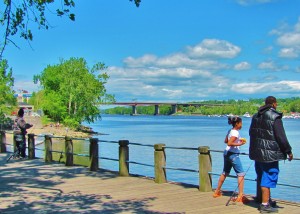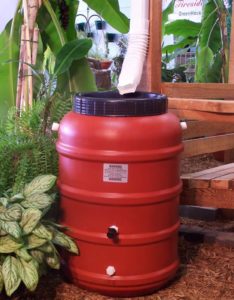Water Quality
CDRPC is a key partner and facilitator of several regional environmental programs that concern water quality, sewer systems, stormwater runoff and climate. These programs include the 604(b) Clean Water and MS4 Storm Sewer programs that focus on water quality and the Combined Sewer Overflow and the Climate Smart Communities.
604(b) Clean Water Program
 The federal Clean Water Act provides for funding to states for regional water quality management planning activities. The Environmental Protection Agency (EPA) awards 604(b) grants to states, which in turn make awards to regional planning and interstate organizations.
The federal Clean Water Act provides for funding to states for regional water quality management planning activities. The Environmental Protection Agency (EPA) awards 604(b) grants to states, which in turn make awards to regional planning and interstate organizations.
The NYS Department of Environmental Conservation provides the availability of funds for Water Quality Management Planning programs that promote regional comprehensive water quality management planning activities as described in Section 604(b) of the federal Clean Water Act. Clean Water Act, Section 604(b) funding provides the financial source for states and territories to pursue water quality planning under Sections 205(j) and 303(e) of the Clean Water Act. This program authorizes the awarding of funds through the Environmental Protection Agency to states for water quality assessment and management planning grants. The 1987 amendments to the Clean Water Act mandated that 40% of each state’s award be granted, or “passed through”, to Regional Public Comprehensive Planning Organizations (RPCPOs) and Interstate Organizations (IOs).
MS4 Stormwater Program
In 1990, the United States Environmental Protection Agency (USEPA) adopted Phase I Stormwater rules under the National Pollutant Discharge Elimination System (NPDES) permit following amendments to the Clean Water Act. Phase I covered large and medium sized Municipal Separate Storm Sewer Systems (MS4s). Typically Phase I communities had populations of 100,000 or more. Construction activity disturbing five or more acres and certain industrial activities were also affected by the rule.
Combined Sewer Overflow (CSO) Abatement
 The Capital District Regional Planning Commission has taken the lead in organizing a consortium to develop a comprehensive inter-municipal Phase I Long-Term Control Plan (LTCP) for Combined Sewer Overflows (CSO): overflows from combined storm & sanitary sewers discharging into the Hudson River Estuary. The participating Albany Pool communities are the Albany Water Board; the cities of Cohoes, Rensselaer, Troy and Watervliet; and the Village of Green Island. Each community currently has its own State Pollutant Discharge Elimination System (SPDES) permit. The Albany & Rensselaer County Sewer Districts are also partners in the consortium.
The Capital District Regional Planning Commission has taken the lead in organizing a consortium to develop a comprehensive inter-municipal Phase I Long-Term Control Plan (LTCP) for Combined Sewer Overflows (CSO): overflows from combined storm & sanitary sewers discharging into the Hudson River Estuary. The participating Albany Pool communities are the Albany Water Board; the cities of Cohoes, Rensselaer, Troy and Watervliet; and the Village of Green Island. Each community currently has its own State Pollutant Discharge Elimination System (SPDES) permit. The Albany & Rensselaer County Sewer Districts are also partners in the consortium.
The Albany Pool of the Hudson River currently has 92 Combined Sewer Overflow points. Combined sewer systems are designed to discharge directly to surface bodies of water such as rivers, estuaries, and coastal waters during wet weather when total flows exceed the capacity of the combined sewer system or the treatment plant.
In 2007, the Pool Communities began working together to develop a joint Long Term Control Plan. The plan was created to study the current health of the Hudson River, identify programs and projects that will aid in the clean-up of the river, and through a sophisticated modeling system and post construction testing program, and demonstrate the effectiveness of the program.
Working with the Department of Environmental Conservation, the Pool will implement more than 50 projects and programs that will significantly improve the water quality of the Hudson River and its tributaries.
Albany Pool Communities Combined Sewer Overflow Long Term Control Plan »
Green Infrastructure Resources
Green Infrastructure Tool Kit
Working in in concert with NYSDEC, CDRPC and their consultant team, led by Barton and Loguidice, evaluated the current Stormwater Design Manual for opportunities to develop specific and expand upon current practices for use in the Albany Pool Communities – and create a tool box the communities can readily employ to evaluate GI practices and encourage or require their adoption to manage stormwater in the Combined Sewer System area.
The Pool Communities, through CDRPC, were awarded grant funding through the New York State Department of State’s Local Government Efficiency Grant Program to fund the development and promotion of the Toolkit and it’s companion project, the Green Infrastructure code Audit.
The goal of the Toolkit is to provide customizable green alternatives to traditional stormwater management on small sites to promote:
- greener landscapes
- reduction of heat island effect
- removal of stormwater pollutants
- reduction in the incidences of combined sewer overflows
The Toolkit emphasizes stormwater management through retention an infiltration with a focus on urban areas and small sites – specifically focusing on volume as it’s main objective rather than water quality because the manual is aimed to communities with combined sewers; overflows and bacterial contamination.
View and download the Toolkit Here.
Stormwater Management, Landscaping and Site Design and The Green Area Ratio
The Town of Colonie requested planning assistance to identify methods of preserving and enhancing greenspace as a component of new development. The Town’s 2019 Comprehensive Plan established several goals and actions identifying the need and opportunity to implement of programs and policies to strengthen Town Code and stormwater management controls to protect environmental assets, enhance quality and quantity of attractive landscaping features and utilize natural methods of stormwater controls to manage stormwater on site.
Green Infrastructure Code Audit
The Green Infrastructure Code Audit, created by the Stormwater Coalition of Albany County and modified by CDRPC, was designed to engage communities in an in‐depth review of how local laws, ordinances, development review, design standards and natural resource protection influence stormwater management. The Audit identifies barriers and gaps in the adoption of Green Infrastructure practices and low impact development. It also leads to a prescriptive set of model local laws and guidelines that can be adopted to encourage and require increased employment of GI as a stormwater management technique – thereby reducing stormwater runoff and improving water quality. This Green Infrastructure Code Audit was developed to provide each community with assistance in developing green infrastructure guidance for public and private application of green infrastructure. The Audit will help communities identify gaps and barriers in local land use code, policy, or stormwater regulations that inhibit or discourage the adoption of GI practices, constructed or policy. The results of the Audit will highlight areas of local code that a community may wish to strengthen.
This project is supported in part by a grant from the New York State Department of Environmental Conservation through it’s “604b” program. Please note: At this time CDRPC is able to provide the results of the Audit only, and not able to provide comprehensive assistance to develop new code or modify existing land use or stormwater regulations.
View the Audit Tool and Associated Resources Here.
Rain Barrels
 Rain barrels can provide homeowners with access to free rainwater for irrigation, gardens and washing vehicles. When installed under a downspout that would otherwise drain to an impervious surface, the barrels can help reduce combined sewer overflows and improve water quality for receiving waters. Recognizing the benefits of rain barrels, the Albany County Soul and Water Conservation District sells barrels for $80. To purchase one click here.
Rain barrels can provide homeowners with access to free rainwater for irrigation, gardens and washing vehicles. When installed under a downspout that would otherwise drain to an impervious surface, the barrels can help reduce combined sewer overflows and improve water quality for receiving waters. Recognizing the benefits of rain barrels, the Albany County Soul and Water Conservation District sells barrels for $80. To purchase one click here.
Below, find helpful resources on the benefits, installation and maintenance of rain barrels.